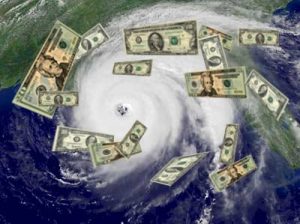A preview of your climate disaster costs
What’s that sucking sound you’re hearing this weekend?
Climate disaster costs that can hollow out your finances.
 Unless you live in the path of Hurricane Harvey, bringing big climate disaster costs to America, you won’t be hearing the sound made by 35 inches of rain flooding towns and cites in 30-50 counties. You won’t hear the whistle of 100-mph winds knocking down buildings, trees, and power lines. Nor the splashing of seawater that’s 12 feet above normal.
Unless you live in the path of Hurricane Harvey, bringing big climate disaster costs to America, you won’t be hearing the sound made by 35 inches of rain flooding towns and cites in 30-50 counties. You won’t hear the whistle of 100-mph winds knocking down buildings, trees, and power lines. Nor the splashing of seawater that’s 12 feet above normal.
But if you listen carefully, you may hear the sound of money being sucked out of Americans’ bank accounts – billions of dollars from family incomes, the housing market, the value of local companies, the coffers of municipalities, and the savings and livelihoods of our fellow Americans.
If Harvey is typical, over the coming weeks and months, tens of thousands of local residents will
have their wages suspended temporarily or permanently;
learn that their local taxes and rates are being raised to repair water, electricity, and municipal assets;
watch property values in their neighborhood take a long-term hit.
And a lot more. Katrina caused $108 billion in damage; Sandy and nine other climate disasters cost between $10 and 100 billion. There’s plenty of evidence that climate disasters are rising in number and cost, and it’s not just ocean storms like Harvey. Away from the coasts, inland flooding and tornadoes are increasing too.
For families in southern Texas and Louisiana this weekend it’s too late to
- arrange for a professional estimate of their climate risks,
- change local zoning to require building protections in flood-prone neighborhoods,
- lobby Washington to put local levees and sea walls into this autumn’s infrastructure bill and keep some form of federal flood insurance, or
- start thinking about choosing a more climate-proof hometown.
But it’s not too late for the rest of America. For those of us in other regions, we can hear a wake-up call coming from Texas: start assessing your own risks and taking steps to protect your finances from the steadily growing climate disaster costs – before you hear them arrive.

